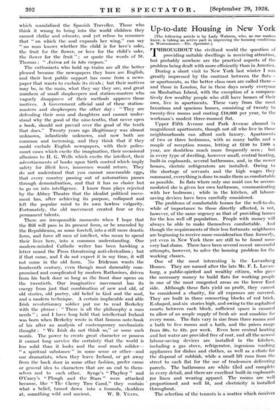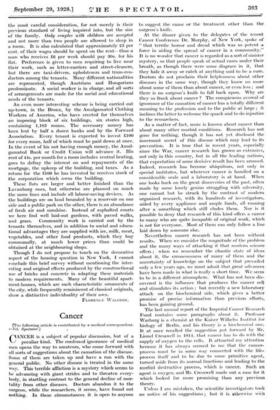Up-to-date Housing in. New York [The following article is by
Lady Walston, who, as our readers know, is taking an active part in improving the housing conditions in Westminster.—En. Spectator.] THROUGHOUT the civilized world the question of providing suitable dwellings is receiving attention, but probably nowhere are the practical aspects of the problem being dealt with more efficiently than in America.
During a short visit to New York last winter I was greatly impressed by the contrast between the flats— or apartments, as the better class ones are called there— and those in London, for in these days nearly everyone on Manhattan Island, with the exception of a compara- tively few wealthy people who still have houses of their own, live in apartments. These vary from the most luxurious and spacious homes, consisting of twenty to twenty-five rooms and costing £10,000 per year, to the workman's modest three-roomed flat.
Upper Fifth Avenue and Park Avenue abound in magnificent apartments, though not all who live in those neighbourhoods can afford such luxury. Apartments of two or three bedrooms, with as many baths and a couple of reception rooms, letting at £240 to £400 a year, are doubtless much more frequently seen ; but in every type of dwelling, however small, central heating, built-in cupboards, several bathrooms, and, in the newer houses, electric refrigerators are installed. Owing to the shortage of servants and the high wages they command, everything is done to make them as comfortable as possible. In flats where only one maid can be accom- modated she is given her own bathroom, communicating with her bedroom ; while in the kitchen, all labour- saving devices have been carefully considered.
The problems of comfortable homes for the well-to-do, while of importance to those directly affected, is not, however, of the same urgency as that of providing homes for the less well off population. People with money will always be able to make themselves comfortable. And though the requirements of their less fortunate neighbours are beginning to receive more consideration than formerly, yet even in New York there are still to be found some very bad slums. There have been several recent successful attempts, however, to solve the housing problem for the working classes.
One of the most interesting is the Lavanburg Homes. They are named after the late Mr. F. L. Lavan- burg, a public-spirited and wealthy citizen, who gave the necessary money to build flats for working people in one of the most congested areas on the lower East side. Although these flats yield no profit, they cannot be considered a charity, for all expenses are covered.
They are built in three connecting blocks of red brick, E-shaped, and six stories high, and owing to the asphalted courts between each block, sufficient space is ensured to allow of an ample supply of fresh air and sunshine for every room. The flats vary in size from three rooms and a bath to five rooms and a bath, and the prices range from 80s. to 42s. per week. Even here central heating and hot water are provided free of cost, and all the newest labour-saving devices are installed in the kitchen, including a gas stove, refrigerator, ingenious 'Washing appliances for dishes and clothes, as well as a chute for the disposal of rubbish, while a small lift runs from the street to each flat for the use of tradesmen delivering parcels. The bathrooms are white tiled and complete in every detail, and there are excellent built-in cupboards for linen and wearing apparel. The rooms are well proportioned and well lit, and electricity is installed throughout.
The selection of the tenants is a matter which receives the most careful- consideration, for not merely is their previous standard of living inquired into, but the size of the family. Only couples with children are accepted and not more than two people are allowed to sleep in a room. It is also calculated that approximately 25 per cent. of their wages should be spent on the rent—thus a man who receives £6 per week should pay 30s. for his flat. Preference is given to men requiring to live near their work, such as letter-carriers and street-cleaners, but there are taxi-drivers, upholsterers and tram-con- ductors among the tenants. Many different nationalities are represented, though Austrians and Hungarians predominate. A social worker is in charge, and all sorts of arrangements are made for the social and educational needs of the tenants.
An even more interesting scheme is being carried out up-town, in the Bronx, by the Amalgamated Clothing Workers of America, who have erected for themselves an imposing block of six buildings, six stories high, containing 1,185 rooms. The necessary money has been lent by half a dozen banks and by the Forward Association. Every tenant is expected to invest £100 for every room, half of which must be paid down at once. In the event of his not having enough money, the Amal- gamated Bank or Credit Union will advance it. His rent of 44s. per month for a room includes central heating, goes to defray the interest on and repayments of the mortgage, the upkeep of the building, and taxes. As a return for the £100 he has invested he receives stock of the corporation which owns the building.
These flats are larger and better finished than the Lavanburg ones, but otherwise are planned on much the same lines and include all labour-saving devices. As the buildings are on land bounded by a reservoir on one side and a public park on the other, there is an abundance of fresh air and sunshine. Instead of asphalted courts we here find well laid-out gardens, with paved walks, and grass. Community work is carried out by the tenants themselves, and in addition to social and educa- tional advantages they are supplied with ice, milk, meat, vegetables, and other food products, which they buy communally, at much lower prices than could be obtained at the neighbouring shops.
Though I do not propose to touch on the decorative aspect of the housing question in New York, I cannot conclude this brief survey without mentioning the inter- esting and original effects produced by the constructional use of bricks and concrete in adapting these materials to modern requirements. Many of the beautiful apart- ment-houses, which are such characteristic ornaments of the city, while frequently reminiscent of classical originals, show a distinctive individuality of their own.
FLORENCE WA LSTON.





































 Previous page
Previous page